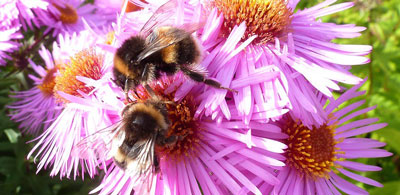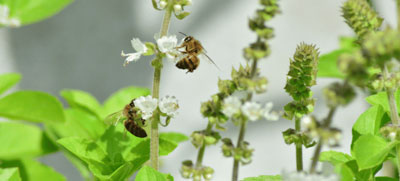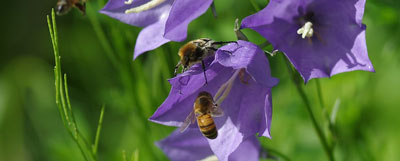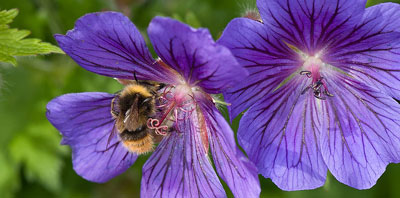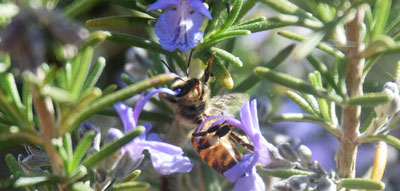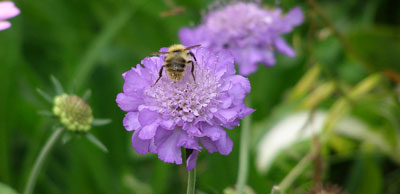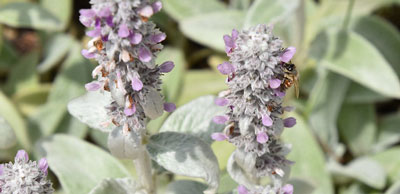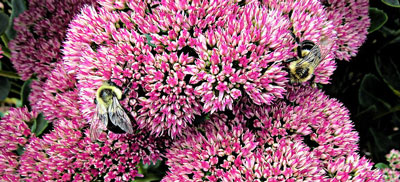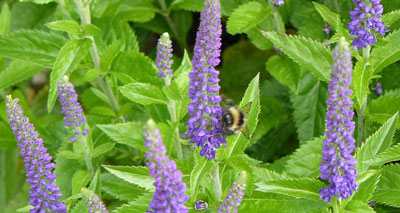Want to help the bees? Plant a bee friendly garden! By choosing the right flowers, you can help to create a beautiful and productive garden that attracts and supports bees. Certain flowers provide nectar and pollen for bees, supporting their overall health and helping to sustain them. Read on to explore our top picks for a bee friendly garden.

Bee Friendly Gardens Make a Difference
What you plant matters. You may have heard the saying: “if bees disappeared off the surface of the globe, then man would have only four years of life left.” According to the United Nations, bees and other insects pollinate about 75% of the world’s food crops. This is why creating bee friendly gardens by planting flowers that attract and support these important insects is so important.
Types of Bees
There are three main types of bees in the world: honeybees, bumblebees, and solitary bees. Solitary bees are the most common type, making up about 85% of all bee species. Solitary bees are very good at pollinating flowers because they drop a lot of pollen while they’re collecting nectar. Bumblebees and honeybees primarily keep it for themselves. And one solitary bee can do the same pollination work as 120 honeybees!
Tiny Bee Tongues
When choosing flowers for a bee friendly garden, it’s important to know that not all flowers are accessible to all bees. Why? It’s about their little tongues! Different bees have different tongue lengths, which directly affect their ability to reach the nectar and pollen.
Some bees, such as honeybees and bumblebees, have shorter tongues. While others, such as carpenter bees and orchid bees, have very long tongues.
This is why it’s so important to choose flowers that are suitable for all types of bees. By selecting plants that are suitable for all types of bees, you can help to create a healthy and diverse ecosystem. One that supports the health and well-being of these important pollinators.
Top Plants for a Bee Friendly Garden
So which flowers are best? Here are some of our top picks for your bee friendly garden:
ASTERS
Asters are great for bees because they bloom in August, September, and October, which is when lots of other flowers aren’t blooming. This provides a much-needed source of nectar and pollen. Aster flowers look like daisies with lots of pretty petals that can be pink, purple, or white, and often surround yellow centers. When asters are in full bloom it’s nothing but color!
BASIL
Basil is a flowering plant that produces small, white, or purple flowers arranged in spikes, or racemes, on the plant. The flowers of basil plants have a sweet, fragrant aroma and pollinators love them. Basil typically blooms in the summer months. Basil is a staple in herb gardens and adds a delectable flavor to lots of different foods.
CAMPANULA
Campanula, also known as bellflowers, is a flowering plant that produces small, blue, purple, or white bell-shaped flowers. These flowers bloom in clusters from June to July and have a delicate, fragrant aroma. Campanula is good for all bees because of its accessible nectar and pollen. Fun fact: harebell mason bees also use this flower as a meeting place while searching for a mate.
CATMINT
Catmint, also known as Nepeta, produces upright flower spikes in shades of lavender-blue, pink or white. Their blooms are highly sought after by all bees for their nectar and pollen. Catmint is effortless to care for and grows like crazy. Additionally, it has an extended flowering period, making it a valuable addition to any bee friendly garden.
CENTAUREA
Centaurea, also known as cornflowers, produces small, blue, purple, or white flowers with a central disk surrounded by petals. It blooms from June to July, with a lighter rebloom in the fall if deadheaded. Centaurea is good for all bees because it produces a lot of accessible nectar and pollen.
CONEFLOWERS
Coneflowers, also known as Echinacea, produce large, daisy-like flowers with a central cone-shaped structure surrounded by petals. The nectar and pollen produced by coneflowers provide a source of energy and nutrition for all bees. They bloom from June to August. As a bonus, the dried seed heads will attract songbirds.
CRANESBILL GERANIUM
Cranesbill geraniums, also known as hardy geraniums, produce flowers that are shaped in such a way that make it easy for bees to access the nectar and pollen. Cranesbill geraniums bloom from June through August.
GAILLARDIA
Gaillardia, also known as blanket flower, produce large, daisy-like flowers with central disks surrounded by petals. The flowers of Gaillardia are orange, yellow, or red and have a bright, showy appearance. It blooms from June to September. Gaillardia is an excellent source of nectar and pollen for bees.
LAVENDER
Lavender is a flowering plant that produces small, purple, pink, or white flowers arranged in spikes or clusters. The flowers have a sweet, fragrant aroma and provide a good amount of nectar and pollen for bees and other pollinators. Lavender blooms in July and August.
ROSEMARY
Rosemary is a perennial herb that produces small, blue, or purple flowers that are attractive to bees. The nectar and pollen produced by rosemary flowers provide a source of energy and nutrition for bees, helping to sustain them and support their overall health. If rosemary is allowed to bloom freely, it will start in April and in June.
SALVIA
Salvia, also known as sage, produces small, purple, pink, or white flowers arranged in spikes or clusters. The flowers have a sweet, fragrant aroma, nectar, and pollen, and pollinators love them. Salvia blooms from May to June and will rebloom in the fall if cut back.
SCABIOSA
Scabiosa, also known as pincushion flowers, produce small, purple, pink, or white flowers with a central disk surrounded by petals. These nectar and pollen-rich flowers start blooming in May and will continue throughout the summer months.
ERYNGIUM
Eryngium, also known as sea holly, is a flowering plant that produces small, blue, purple, or white flowers with a central disk surrounded by spiny bracts. Eryngium blooms from July to September, providing an excellent source of nectar and pollen for the bees.
STACHYS
Stachys, also known as lamb’s ears, is a flowering plant that produces small, purple, pink, or white flowers arranged in spikes or clusters on the plant. The flowers of Stachys have a sweet, fragrant aroma and are visited by bees and other pollinators for the nectar and pollen they produce. Stachys bloom from May to July.
STONECROP
Stonecrop, also known as Sedum, is a drought-tolerant plant that produces small, colorful flowers that are attractive to bees for their nectar and pollen. It typically blooms from June to September.
SUNFLOWERS
Sunflowers are single-stalked plants that produce large, bright yellow flowers with a central disk surrounded by petals. They bloom from July to September. Sunflowers are excellent for bee friendly gardens because of the nectar and pollen they produce.
THYME
Thyme is an herb that produces small, purple, or white flowers with lots of nectar and pollen that bees love. For cooking, thyme pairs well with meats of all kinds, chicken, stews, soups, eggs, pasta, vegetables, and beans. If not cut back, it typically blooms from May to June.
VERONICA
Veronica is a flowering plant that produces small, blue, purple, or white flowers. The flowers of veronica are arranged in spikes or racemes on the plant and have a tubular shape that is highly attractive to bees. Veronica blooms in the summer and early fall months, from June to August.
Planting bee friendly flowers is essential for the health and well-being of bees and other pollinators. Ready to get started? Check out our flowers for bees!




























































































































































































































































































































































































































































































































































































































































